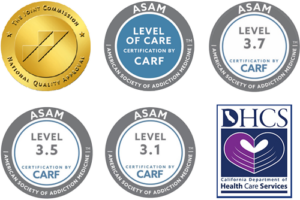How Long Does Fentanyl Stay in Urine?
How long does fentanyl stay in your system? Our guide provides all the details you’ll need.
As a powerful synthetic opioid known for its extreme potency, fentanyl has both legitimate and illicit uses. When ingested, fentanyl can produce a range of powerful effects, including pain relief, sedation, euphoria, and relaxation. However, its high potency also means there is a significant risk of addiction and overdose, which can be fatal even in small amounts.
Due to its potential for abuse and its involvement in a growing number of overdose deaths, there is an increasing focus on detecting fentanyl in urine drug tests and other drug testing methods to detect its presence in individuals and communities affected by opioid abuse.
In this guide, we will explore what fentanyl is, the concepts of opioid addiction and fentanyl testing, and how fentanyl addiction treatment can help people regain their lives.
PSA: Keep Your Job, Stay Out of Jail
If substance abuse is a concern and you’re at risk of losing your job due to a positive test for illegal drugs, there’s still hope. Your job is safe if you choose to seek residential treatment or other forms of treatment for your addiction—your employer cannot legally terminate your employment.
This protection also extends to individuals on probation or parole who must undergo drug testing. Testing positive doesn’t mean heading to jail if you agree to enter treatment. At Journey Hillside Tarzana, we can support your recovery journey with our extensive addiction treatment programs and expert guidance. Overcome the fear and stigma associated with addiction by turning to our skilled substance abuse professionals, all within a nurturing, supportive, and healing environment. Contact our intake specialists today at (877) 761-2723.
So, How Long Does Fentanyl Stay in Your System?
The duration that fentanyl, a potent synthetic opioid, remains detectable in your system varies depending on several factors, including the amount used, frequency of use, metabolic rate, body mass index (BMI), age, and overall health. However, general fentanyl detection windows by test type are as follows:
- Urine Tests: Fentanyl can be detected in urine for 1 to 3 days after the last use. This is referred to as the drug’s half life. This is the most common form of testing for the presence of fentanyl and other opioids.
- Blood Tests: Fentanyl is detectable in blood tests for up to 12 to 48 hours after the last use. Blood tests have a shorter detection window because fentanyl is rapidly metabolized and cleared from the bloodstream.
- Saliva Tests: This method can detect fentanyl from 1 to 4 days after the last use. Saliva testing is less invasive and becoming more common, but its detection window can vary based on the specifics of the drug’s use.
- Hair Follicle Tests: Fentanyl can be detected in hair for up to 90 days or longer after the last use. Hair tests provide the longest record of drug use, though there’s typically a lag of a week or more from the last use to when the drug can be detected in hair.
It’s important to note that these time frames for how long fentanyl stays in our body are estimates and can vary significantly from person to person. Fentanyl’s potent and fast-acting nature means it’s metabolized quickly by the body, but the remnants of the drug and its metabolites can linger and be detectable for a period after use.
What is Fentanyl?
Fentanyl is in a class of drugs known as synthetic opioids, or substances produced in a laboratory that act on the same chemical targets in the human brain as naturally-derived opiates (those extracted from the seed pods of certain poppy flowers).
The primary goal of fentanyl is to treat severe pain, and this substance has been used by the medical community for decades. Unfortunately, fentanyl is relatively easy to synthesize in clandestine laboratories, resulting in high availability on the illegal market and popularity for abuse.
What are Opioid Receptors?
Opioid receptors are a group of G protein-coupled receptors found in the central and peripheral nervous system and the gastrointestinal tract. These receptors are the binding sites for opioids, including natural endogenous peptides like endorphins and enkephalins, synthetic drugs such as fentanyl and morphine, and semi-synthetic compounds like heroin. There are three main types of opioid receptors:
- Mu (μ) receptors: These are primarily responsible for opioids’ pain-relieving (analgesic) effects, as well as euphoria and, unfortunately, addiction. Activation of mu receptors can also lead to respiratory depression, which is the primary cause of overdose fatalities.
- Delta (δ) receptors: Their exact role is less well understood, but they are believed to contribute to analgesia and also play a role in mood regulation. Activation of delta receptors may also affect the immune system.
- Kappa (κ) receptors: Activation of these receptors can produce analgesia and sedation. However, unlike mu receptor activation, kappa receptor activation is often associated with dysphoria and hallucinations.
Illicit Fentanyl vs. Medical Fentanyl
The primary difference between illicit fentanyl and medical fentanyl lies in their legality, control, purpose of use, and the risks associated with their consumption. The Drug Enforcement Agency (DEA) provides the following information to compare the two forms of fentanyl:
- Legality and Control:
- Medical Fentanyl is legally manufactured and prescribed by healthcare professionals. It is strictly regulated by authorities like the U.S. Food and Drug Administration (FDA) to ensure its safety and efficacy. Medical fentanyl is used in controlled settings for specific medical purposes, such as treating severe pain or as anesthesia during surgery.
- Illicit Fentanyl is produced and distributed without legal authorization. It often appears on the street mixed with other drugs or misrepresented as other opioids, which significantly increases the risk of opioid overdose due to its potent nature. The lack of regulation and quality control in illicit fentanyl production leads to variable potency and contaminants that add to its danger. Drug enforcement administration officials are working around the clock to stop the flow of this illegal drug into the United States with the goal to eliminate fentanyl in all but carefully-controlled medical uses.
- Purpose of Use:
- Medical Fentanyl is prescribed for managing acute and chronic pain, especially in cancer patients or after surgeries. Its use is intended to be short-term, under the supervision of a healthcare provider, and at doses carefully adjusted for the individual’s needs. It can be used as an injectable solution, a transdermal patch, or a solid lozenge.
- Illicit Fentanyl is typically used for recreational purposes, seeking euphoria or to maintain an opioid addiction. It is often mixed with heroin, cocaine, or pressed into pills that mimic other prescription opioids, increasing the risk of unintentional overdoses among users unaware of the fentanyl content. Fentanyl exposure, even through incidental contact, can affect the central nervous system and has a high potential for negative complications.
- Risks and Safety:
- Medical Fentanyl comes with guidelines for its safe use, including dosing instructions, potential side effects, and monitoring for signs of dependence or overdose. When used as prescribed, it can be an effective part of pain management.
- Illicit Fentanyl carries a high risk of overdose and death, primarily because users are often unaware of its presence in the substances they consume. Its illegal production means there’s no quality control or standardized dosing, making it extremely dangerous.
Fentanyl Withdrawal Symptoms
Fentanyl withdrawal can be very uncomfortable, and the symptoms are similar to those seen with other opioids, but they can be more intense due to fentanyl’s high potency. The symptoms usually start within a few hours after the last dose and can include:
- Intense cravings for the drug.
- Muscle and joint pains.
- Restlessness and difficulty sleeping.
- Stomach problems like nausea, vomiting, and diarrhea.
- Cold flashes with goosebumps.
- Severe mood swings, including anxiety and depression.
These opioid withdrawal symptoms can be quite distressing, but they are typically not life-threatening. However, the intensity of the withdrawal can make it difficult to quit without medical help.
How Do You Define Fentanyl Addiction?
Fentanyl addiction is defined by a pattern of compulsive drug use despite the negative consequences it brings to the individual’s health, social relations, and functioning. Like other substance use disorders, fentanyl addiction encompasses several key features, including both physical and psychological symptoms:
- Tolerance, or how much of the drug needs to be used to achieve the same effects.
- Dependence, or the physical and psychological need for the drug when a user attempts to cut down or quit fentanyl abuse.
- Compulsive use, or use in the face of negative consequences.
- Loss of control, or a user’s inability to reduce or quit the drug.
- Withdrawal symptoms, or the unpleasant effects caused by abruptly stopping the drug.
Fentanyl addiction — or any opioid addiction — is a medical condition that requires professional treatment, which may include medication-assisted therapy (MAT), counseling, and support groups. Addressing addiction often involves comprehensive approaches that cater to the physical and psychological aspects of the disorder.
Fentanyl Abuse Disorder
This disorder, falling under the broader category of opioid use disorder, is characterized by a pattern of fentanyl use that leads to significant impairment or distress. People with fentanyl use disorder may find themselves using more fentanyl than intended, have a persistent desire to cut down or control use without success, and continue using fentanyl despite the problems it causes in their lives, such as health issues, relationship difficulties, or financial problems.
Like other substance use disorders, fentanyl use disorder varies in severity and requires professional treatment, which might include medications, therapy, and support groups, to manage and overcome.
Important Information About Drug Testing
Employers often require drug tests before offering positions to prospective employees. For some jobs, routine or randomized drug screening is also used to help prevent drug abuse among employees.
If you’ve ever wondered, “how long does fentanyl stay in your system?” when seeking a job or when facing a company-mandated drug test, the information in the previous section can be helpful.
It is important to note, however, that in many areas, testing positive for an illicit drug like fentanyl or other drugs doesn’t have to mean the end of your job. In these cases, enrolling in a rehab facility or drug detox unit can ensure you get the help you need without losing access to your pay. Journey Hillside Tarzana can facilitate treatment, even if a drug test results in a job-threatening situation.
Drug Abuse and Fentanyl Addiction Treatment at Journey Hillside Tarzana
At Journey Hillside Tarzana, we understand that detoxification is the crucial first step towards sobriety. Medical detox is one of the cornerstones of drug and alcohol addiction treatment, helping the body overcome both physical and psychological effects of an addiction.
We offer Medication-Assisted Treatment (MAT) as part of our detox programs, combining evidence-based forms of therapy with medication when necessary. This combination helps our clients safely and successfully detox while alleviating the symptoms of withdrawal. Medication-assisted treatment is one of the most powerful tools in the drug addiction treatment; addiction treatment centers report excellent results with this unique and effective evidence-based treatment.
Our experienced and compassionate team designs customized detox and opioid treatment plans, tailored to your unique needs. Throughout the process, you’ll receive medical supervision and support in a safe environment, ensuring a positive start to your recovery journey.




